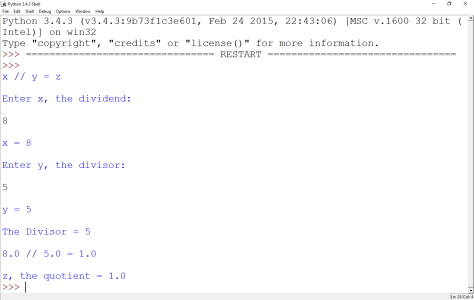(Click the below link for a Microsoft Word version of this blog-post)
(Click the below link for a pdf version of this blog-post)

Figure 1: The Floor-Division operator. In Python, the Floor-Division operator consists of two forward slashes. The Floor-Division operator is an example of a binary operator, as it takes two operands: the dividend and the divisor.
With floor division, one number, the dividend, is divided by another number, the divisor, and the result, or quotient – whatever it may happen to be – will be a rounded-down integer value.
Let us consider the Python Equation:
>>>8/5
1.6
>>>
The number, 8, the dividend, is divided by the divisor, 5, and a floating-point number, 1.6, is then returned as a quotient.

Figure 2: When we divide 8 by 5 using the division operator, / , then a floating-point number, 1.6, is returned as a quotient.

Figure 3: This is our Division operator. When we employ this binary operator, a floating-point number will be returned.
Whenever we employ a Division operator in Python, then a floating point number will always be returned as a quotient, even if the quotient has no significant fractional component.

Figure 4: Whenever we divide the dividend, 8, by the divisor, 4, then the quotient, 2.0, is still returned as a floating-point number despite its not having any significant fractional component.
Let us, again, consider the Python equation:
>>>8/5
1.6
>>>
, but let us do things a little differently:
>>>8//5
1
>>>
In the above example, we have now employed the floor-division operator. The floor-division operator will always return an integer value, if the 2 operands that it takes be integers.

Figure 5: When we divide the dividend, 8, by the divisor, 5, we get the quotient, 1, rendered as an integer.
Let us consider 8 divided by 2 in ordinary arithmetic for a moment:
8 ÷ 5 = 1.6
In the above example, we divide an integer by an integer and we obtain a real number as a result, or quotient.
If we wanted a less precise answer, then it would be customary to see:
8 ÷ 5 ≈ 2
In normal arithmetic, it would be customary to round:
1.6
up to:
2
.
However, in floor division, floating point numbers such as:
>>>1.6
1.6
>>>
are always rounded down to the value of its integral component.
So, in Python, the floor value of:
>>>1.6
1.6
>>>
would be:
>>>2
2
>>>
The floor-division operator will always return an integer as a quotient, unless floating-point numbers be employed as operands.

Figure 6: When we divide 7.9 by 3.2 in conventional division, we obtain the floating-point quotient, 2.46875

Figure 7: When we divide 7.9 by 3.2 in floor division, we still obtain a floating-point quotient, 2.0, but it does not have a significant fractional component.
Programming a Floor-Division Calculator in Python:
In the following section, we shall program a simple floor-division calculator in Python:

Figure 8: A simple floor-division calculator programmed in Python. This program requests that the user input two numbers. The program then takes these inputs; divides the dividend by the divisor; and then returns a rounded-down quotient.

Figure 9: What the previous program, depicted in Figure 8, outputs when run.
